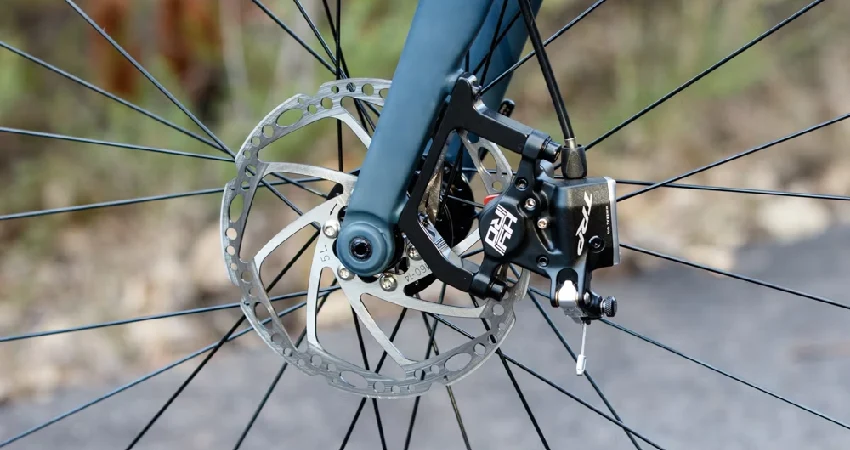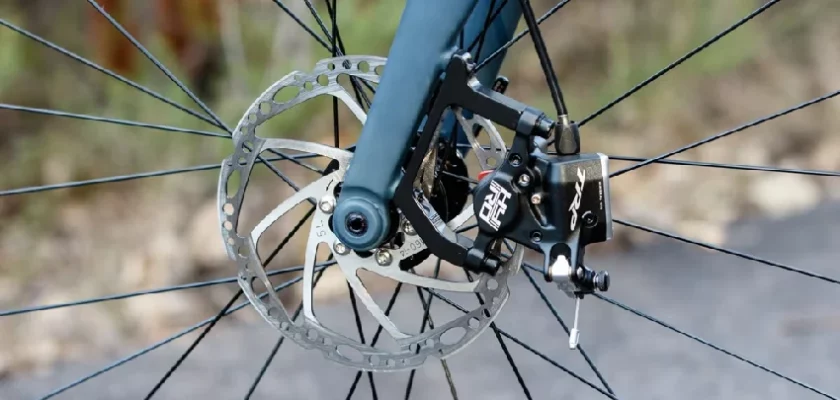Have you ever wondered if it’s possible to retrofit disc brakes to a bike? The answer is, yes, you can! If your current bike is equipped with traditional rim brakes and you’re considering upgrading to the superior stopping power and performance of disc brakes, you’ll be glad to know that it’s a feasible option.
In this blog article, we’ll delve into the world of retrofitting disc brakes onto your beloved two-wheeler. So, if you’ve been craving better braking capabilities on your bike, keep reading to discover everything you need to know about retrofitting disc brakes to a bike.
Adding Disc Brakes To A Bike: Can You Retrofit?

Disc brakes have gained immense popularity among cyclists in recent years due to their superior stopping power and performance in various conditions. If you own a bike with traditional rim brakes, you might be wondering if it is possible to retrofit disc brakes to your bike.
Understanding Disc Brakes
Before we dive into the retrofitting process, it’s essential to understand the fundamentals of disc brakes. Disc brakes utilize a rotor attached to the wheel hub, which is squeezed by a caliper housing brake pads.
When the brake lever is squeezed, hydraulic fluid or cable tension is used to transfer force to the brake caliper, causing the brake pads to grip the rotor, resulting in deceleration or stopping the bike.
Potential Benefits of Retrofitting Disc Brakes
Retrofitting disc brakes to your bike can offer a range of advantages over traditional rim brakes, including:
1. Enhanced Braking Performance: Disc brakes provide consistent and reliable braking performance, even in wet or muddy conditions. They offer improved modulation, which allows for more precise control over braking power.
2. Increased Stopping Power: Compared to rim brakes, disc brakes provide superior stopping power, allowing you to stop quickly and safely, particularly during downhill descents or emergency situations.
3. Better Heat Dissipation: Disc brakes are less prone to heat build-up compared to rim brakes since the rotor is separate from the wheel rim. This feature reduces the risk of “brake fade” during prolonged braking, maintaining consistent performance.
4. Low Rim Wear: With rim brakes, braking action occurs directly on the wheel rim, leading to wear over time. Retrofitting disc brakes eliminates rim wear issues, prolonging the lifespan of your wheelset.
The Retrofitting Process
While retrofitting disc brakes may be possible for some bikes, it’s important to note that it can be more complicated and costly compared to purchasing a bike with pre-installed disc brakes.
The feasibility of retrofitting disc brakes depends on several factors, such as the bike’s frame design, fork compatibility, and available mounting points. Here’s an overview of the retrofitting process:
1. Frame and Fork Compatibility
To retrofit disc brakes, your bike’s frame and fork need to have the necessary attachment points and clearance for the disc brake calipers and rotors. Look for specific features that indicate compatibility:
– Disc brake mounts: Check if your frame and fork have the necessary mounts for attaching disc brake calipers. Common types include International Standard (IS) mounts and Post Mounts.
– Dropout spacing: Ensure that your frame’s rear dropout spacing is compatible with the disc brake hub. Most modern bikes have a standard spacing of 135mm for mountain bikes and 130mm for road bikes.
– Fork construction: If you plan to retrofit disc brakes to a bike with a suspension fork, make sure the fork is disc brake compatible. Some older suspension forks may lack the necessary attachment points.
2. Wheel and Hub Considerations
Retrofitting disc brakes also requires compatible wheels and hubs:
– Hub compatibility: Verify that your wheel hubs are designed to accept disc brake rotors. This information is typically available in the manufacturer’s specifications or by examining the hub for the necessary mounts.
– Rotor size compatibility: Disc brake rotors come in various sizes, commonly 140mm and 160mm. Ensure that there is enough clearance between the brake caliper and the rotor, allowing for proper installation and avoiding interference.
3. Brake Caliper and Lever Compatibility
When retrofitting disc brakes to your bike, you’ll also need to consider compatibility between the brake calipers and brake levers:
– Brake caliper type: Choose between mechanical disc brakes, which operate with a cable actuation system, or hydraulic disc brakes that utilize hydraulic fluid for braking action. Ensure that your brake caliper type matches the brake lever type you plan to use.
– Brake lever compatibility: Check if your current brake levers are compatible with the chosen disc brake system. Some brake levers are specifically designed for rim brakes and may not work with disc brake calipers.
4. Installation
Once you have verified compatibility, installing disc brakes on your bike typically involves the following steps:
– Remove existing rim brake components: Uninstall the rim brake calipers, brake levers, and associated cables or hydraulic lines.
– Install disc brake calipers: Mount the disc brake calipers onto the frame and fork using the appropriate mounting brackets. Align the calipers with the disc brake rotor to ensure proper braking performance.
– Install disc brake rotors: Attach the disc brake rotors to the wheel hubs using the provided lockrings. Make sure they are tightly secured and properly aligned.
– Connect brake hoses or cables: For hydraulic disc brakes, connect the hydraulic hoses and bleed the brake fluid as per the manufacturer’s instructions. For mechanical disc brakes, adjust the cable tension and attach the cables securely.
Considerations and Limitations
While retrofitting disc brakes can provide several benefits, there are certain limitations and considerations to keep in mind:
– Cost: Retrofitting disc brakes can be more expensive than purchasing a bike with factory-installed disc brakes. Aside from the brake components themselves, you might need to invest in new wheels, hubs, and potentially a new fork.
– Technical expertise: The retrofitting process requires some technical knowledge and skill. If you are not confident in your abilities, it’s recommended to seek professional assistance to ensure proper installation and performance.
– Frame integrity: Before retrofitting disc brakes, consider the age and condition of your bike’s frame. Older frames might not be designed to handle the additional forces generated by disc brakes, potentially compromising safety and structural integrity.
– Weight considerations: Retrofitted disc brakes may add weight to your bike compared to rim brakes. While the weight difference is usually minimal, weight-conscious riders should be aware of this potential increase.
Frequently Asked Questions
1. Can I add disc brakes to my existing bike?
Yes, it is possible to retrofit disc brakes to your bike. However, you may need to buy compatible parts and ensure your frame and fork have the necessary mounts for disc brakes.
2. Do I need to replace my wheels to install disc brakes?
No, you don’t necessarily need to replace your wheels. Most modern disc brakes can be installed on standard bike wheels, as long as they have the appropriate disc brake mounts.
3. Are disc brakes more effective than rim brakes?
Disc brakes generally offer better stopping power and modulation compared to rim brakes. They perform well in wet and muddy conditions and are less affected by rim wear. However, the overall effectiveness depends on various factors such as the quality of the brake system and the rider’s preferences.
4. Can I install disc brakes on any type of bike?
While disc brakes are commonly found on mountain bikes, they can also be installed on road bikes, hybrids, and even some older bikes. However, it is important to ensure the bike frame and fork have the necessary mounts and clearance for the rotor and caliper.
5. Can I retrofit disc brakes myself?
Retrofitting disc brakes requires a certain level of mechanical knowledge. If you are comfortable working with bike components, you can do it yourself. However, it is recommended to consult a professional bike mechanic if you are unsure or inexperienced to ensure proper installation and safety.
Final Thoughts
In conclusion, retrofitting disc brakes to a bike is indeed possible. It not only improves the braking performance but also provides increased stopping power and control, especially in adverse weather conditions. Whether you have a traditional rim brake or a coaster brake system, there are various conversion kits available in the market that can be easily installed.
Although it may require some technical expertise and adjustments, the benefits of disc brakes make them a worthwhile upgrade for any cycling enthusiast. So, if you’re looking to enhance your bike’s braking capabilities, consider retrofitting disc brakes to your bike for a safer and more enjoyable riding experience.

